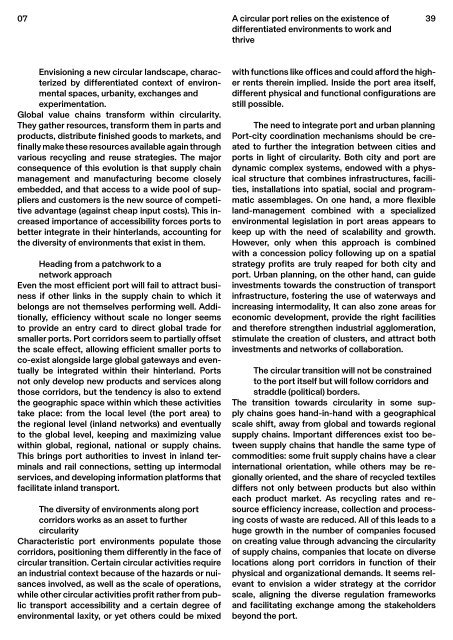Circular City Ports - Synthesis
Create successful ePaper yourself
Turn your PDF publications into a flip-book with our unique Google optimized e-Paper software.
07 <br />
A circular port relies on the existence of<br />
differentiated environments to work and<br />
thrive<br />
39<br />
Envisioning a new circular landscape, characterized<br />
by differentiated context of environmental<br />
spaces, urbanity, exchanges and<br />
experimentation.<br />
Global value chains transform within circularity.<br />
They gather resources, transform them in parts and<br />
products, distribute finished goods to markets, and<br />
finally make these resources available again through<br />
various recycling and reuse strategies. The major<br />
consequence of this evolution is that supply chain<br />
management and manufacturing become closely<br />
embedded, and that access to a wide pool of suppliers<br />
and customers is the new source of competitive<br />
advantage (against cheap input costs). This increased<br />
importance of accessibility forces ports to<br />
better integrate in their hinterlands, accounting for<br />
the diversity of environments that exist in them.<br />
Heading from a patchwork to a<br />
network approach<br />
Even the most efficient port will fail to attract business<br />
if other links in the supply chain to which it<br />
belongs are not themselves performing well. Additionally,<br />
efficiency without scale no longer seems<br />
to provide an entry card to direct global trade for<br />
smaller ports. Port corridors seem to partially offset<br />
the scale effect, allowing efficient smaller ports to<br />
co-exist alongside large global gateways and eventually<br />
be integrated within their hinterland. <strong>Ports</strong><br />
not only develop new products and services along<br />
those corridors, but the tendency is also to extend<br />
the geographic space within which these activities<br />
take place: from the local level (the port area) to<br />
the regional level (inland networks) and eventually<br />
to the global level, keeping and maximizing value<br />
within global, regional, national or supply chains.<br />
This brings port authorities to invest in inland terminals<br />
and rail connections, setting up intermodal<br />
services, and developing information platforms that<br />
facilitate inland transport.<br />
The diversity of environments along port<br />
corridors works as an asset to further<br />
circularity<br />
Characteristic port environments populate those<br />
corridors, positioning them differently in the face of<br />
circular transition. Certain circular activities require<br />
an industrial context because of the hazards or nuisances<br />
involved, as well as the scale of operations,<br />
while other circular activities profit rather from public<br />
transport accessibility and a certain degree of<br />
environmental laxity, or yet others could be mixed<br />
with functions like offices and could afford the higher<br />
rents therein implied. Inside the port area itself,<br />
different physical and functional configurations are<br />
still possible.<br />
The need to integrate port and urban planning<br />
Port-city coordination mechanisms should be created<br />
to further the integration between cities and<br />
ports in light of circularity. Both city and port are<br />
dynamic complex systems, endowed with a physical<br />
structure that combines infrastructures, facilities,<br />
installations into spatial, social and programmatic<br />
assemblages. On one hand, a more flexible<br />
land-management combined with a specialized<br />
environmental legislation in port areas appears to<br />
keep up with the need of scalability and growth.<br />
However, only when this approach is combined<br />
with a concession policy following up on a spatial<br />
strategy profits are truly reaped for both city and<br />
port. Urban planning, on the other hand, can guide<br />
investments towards the construction of transport<br />
infrastructure, fostering the use of waterways and<br />
increasing intermodality, It can also zone areas for<br />
economic development, provide the right facilities<br />
and therefore strengthen industrial agglomeration,<br />
stimulate the creation of clusters, and attract both<br />
investments and networks of collaboration.<br />
The circular transition will not be constrained<br />
to the port itself but will follow corridors and<br />
straddle (political) borders.<br />
The transition towards circularity in some supply<br />
chains goes hand-in-hand with a geographical<br />
scale shift, away from global and towards regional<br />
supply chains. Important differences exist too between<br />
supply chains that handle the same type of<br />
commodities: some fruit supply chains have a clear<br />
international orientation, while others may be regionally<br />
oriented, and the share of recycled textiles<br />
differs not only between products but also within<br />
each product market. As recycling rates and resource<br />
efficiency increase, collection and processing<br />
costs of waste are reduced. All of this leads to a<br />
huge growth in the number of companies focused<br />
on creating value through advancing the circularity<br />
of supply chains, companies that locate on diverse<br />
locations along port corridors in function of their<br />
physical and organizational demands. It seems relevant<br />
to envision a wider strategy at the corridor<br />
scale, aligning the diverse regulation frameworks<br />
and facilitating exchange among the stakeholders<br />
beyond the port.


















